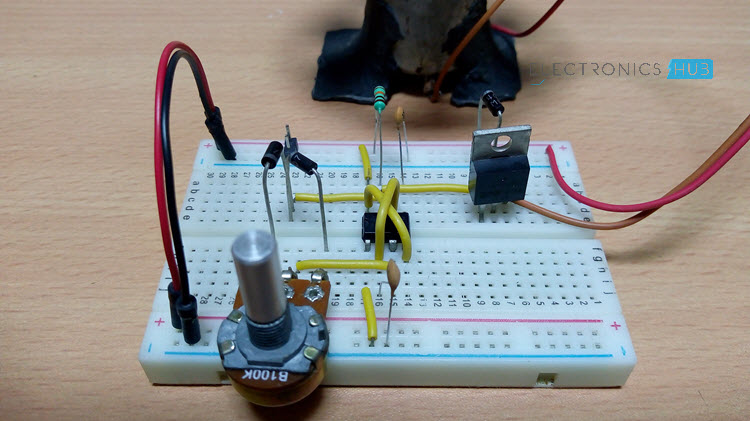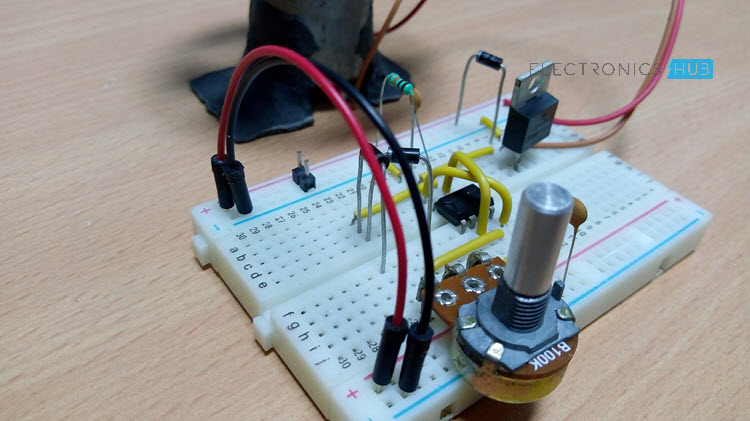We use DC Motors in many systems in our day to day life. For example, CPU fans, fume extinguishers, toy cars etc. are all DC Motors which are operated by DC power supply. Most of the times we will have to adjust the speed of the motors as per our requirement. A CPU Fan for example, must be operated at high speed when the CPU is preforming heavy tasks like games or video editing. But for normal usage like editing documents, the speed of the fan can be reduced. Although some systems have an automatic adjustment system for fan speed, not all systems possess this functionality. So, we will have to adjust the speed of the DC Motor ourselves occasionally.
How Speed Control of DC Motor is implemented?
There are multiple ways to adjust the speed of a DC Motor manually. The simplest way to achieve this is with the help of a variable resistor i.e. we can adjust the speed of a DC Motor by using a variable resistance in series with the motor. But this method is usually not prepared for two reasons. The first reason is energy wastage i.e. the resistor dissipates the excess energy as heat. The second reason is if we want to use any devices like microcontrollers or any other digital equipment for automating our DC Motor speed control, then this method cannot be used. A more efficient way to proceed is by using Pulse Width Modulation technique to Control the speed of our DC motor.
Circuit Diagram of PWM Based DC Motor Speed Control
Components Required
555 Timer IC 12V DC Motor 1N5819 x 2 1N4007 100nF 100pF 10KΩ Resistor 100KΩ Potentiometer IRF540 MOSFET Mini Breadboard 12V Power Supply Connecting Wires
Circuit Design
I am not going to explain the Pin Diagram of 555 IC and willassume that you are already familiar with that. Continuing to design of the circuit, Pin 1 of 555 is connected to GND. Pins 8 and 4 are connected to +12V Supply. Pins 6 and 2 are short and a 100nF Capacitor is connected between Pin 2 and GND. The wiper pin of the POT is connected to Pin 3 of 555. Two Schottky diodes (1N5819) are connected to the other two pins of the POT as shown in the circuit diagram. The common point of the diodes is connected to Pin 2. Pin 7 is pulled high with the help of a 10KΩ Resistor. The Gate terminal of the MOSFET is connected to Pin 7 of 555. The motor is connected between +12V Supply and Drain of MOSFET while the Source of MOSFET is connected to GND. A PN Junction Diode is connected across the Motor terminals to prevent the back emf. NOTE: I haven’t used the Schottky Diodes but replaced them with simple 1N4007 Diodes as the frequency of the PWM is less (around 220Hz).
How Speed Control of DC Motor Circuit Works?
In this circuit, the DC motor is operated by a 555 integrated circuit. The IC 555 in this circuit is being operated in astable mode, which produces a continuous HIGH and LOW pulses. In this mode, the 555 IC can be used as a pulse width modulator with a few small adjustments to the circuit. The frequency of operation of the circuit is provided by the passive parameters of resistances and capacitors attached to it.
NOTE:
One of the best things about this circuit is that you can make it work as an astable multivibrator with little hardware and little cost, which can save both the cost involved in making it as well as the space on the printed circuit board (PCB). If you want a sophisticated pulse width modulator which works more accurately and which can have more adjusting capabilities, then it is better to use a microcontroller based pulse width modulator than the one which we are using now. However, the circuit or the application for which we are using a pulse width modulator is not so sensitive and hence does not demand so much of accuracy. In such a case, the circuit which we are using with a bare IC 555 is better as it saves our monetary as well as space resources in building the circuit. The duty cycle of the circuit can be changed by changing the value of the potentiometer. If we increase the duty cycle, the speed of the motor increases and if we decrease the duty cycle, the speed of the motor decreases.
ID @ 25°C – Continuous Drain Current, VGS @ 10V – 202 A ID @ 100°C – Continuous Drain Current, VGS @ 10V – 143 A Maximum Junction Temperature (Tj): 150 °C You cann’t imagine just how much time I had spent for this information! Thanks! Comment * Name * Email * Website
Δ








![]()